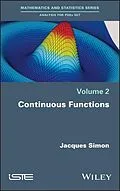This book is the second of a set dedicated to the mathematical tools used in partial differential equations derived from physics. It presents the properties of continuous functions, which are useful for solving partial differential equations, and, more particularly, for constructing distributions valued in a Neumann space. The author examines partial derivatives, the construction of primitives, integration and the weighting of value functions in a Neumann space. Many of them are new generalizations of classical properties for values in a Banach space. Simple methods, semi-norms, sequential properties and others are discussed, making these tools accessible to the greatest number of students - doctoral students, postgraduate students - engineers and researchers, without restricting or generalizing the results.
Autorentext
Jacques Simon is Honorary Research Director at CNRS. His research focuses on Navier-Stokes equations, particularly in shape optimization and in the functional spaces they use.
Inhalt
Introduction ix
Familiarization with Semi-normed Spaces xiii
Notations xv
Chapter 1. Spaces of Continuous Functions 1
1.1. Notions of continuity 1
1.2. Spaces C(;E), Cb(;E), CK(;E), C(;E) and Cb(;E) 3
1.3. Comparison of spaces of continuous functions 6
1.4. Sequential completeness of spaces of continuous functions 10
1.5. Metrizability of spaces of continuous functions 11
1.6. The space K(;E) 14
1.7. Continuous mappings 20
1.8. Continuous extension and restriction 22
1.9. Separation and permutation of variables 23
1.10. Sequential compactness in Cb(;E) 28
Chapter 2. Differentiable Functions 31
2.1. Differentiability 31
2.2. Finite increment theorem 34
2.3. Partial derivatives 37
2.4. Higher order partial derivatives 40
2.5. Spaces Cm(;E), Cmb (;E), CmK(;E), Cmb (;E) and Km(;E) 42
2.6. Comparison and metrizability of spaces of differentiable functions 45
2.7. Filtering properties of spaces of differentiable functions 47
2.8. Sequential completeness of spaces of differentiable functions 49
2.9. The space Cm(;E) and the set Cm(;U) 52
Chapter 3. Differentiating Composite Functions and Others 55
3.1. Image under a linear mapping 55
3.2. Image under a multilinear mapping: Leibniz rule 59
3.3. Dual formula of the Leibniz rule 63
3.4. Continuity of the image under a multilinear mapping 65
3.5. Change of variables in a derivative 69
3.6. Differentiation with respect to a separated variable 72
3.7. Image under a differentiable mapping 73
3.8. Differentiation and translation 77
3.9. Localizing functions 79
Chapter 4. Integrating Uniformly Continuous Functions 83
4.1. Measure of an open subset of d 83
4.2. Integral of a uniformly continuous function 87
4.3. Case where E is not a Neumann space 92
4.4. Properties of the integral 93
4.5. Dependence of the integral on the domain of integration 96
4.6. Additivity with respect to the domain of integration 99
4.7. Continuity of the integral 101
4.8. Differentiating under the integral sign 103
Chapter 5. Properties of the Measure of an Open Set 105
5.1. Additivity of the measure 105
5.2. Negligible sets 107
5.3. Determinant of d vectors 112
5.4. Measure of a parallelepiped 115
Chapter 6. Additional Properties of the Integral 119
6.1. Contribution of a negligible set to the integral 119
6.2. Integration and differentiation in one dimension 120
6.3. Integration of a function of functions 123
6.4. Integrating a function of multiple variables 125
6.5. Integration between graphs 130
6.6. Integration by parts and weak vanishing condition for a function 133
6.7. Change of variables in an integral 135
6.8. Some particular changes of variables in an integral 142
Chapter 7. Weighting and Regularization of Functions 147
7....
